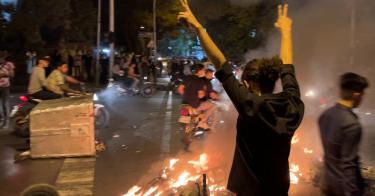Last Wednesday, while Iranian president Ibraham Raisi addressed the United Nations General Assembly, insisting that countries such as Canada and U.S. had human-rights records equivalent to—if not worse than—Iran’s, protests erupted across the Islamic Republic. What sparked the protests was the beating death of 22-year-old Mahsa Amini, killed by the morality police, who had arrested her for violating the country’s strict requirement that women wear the hijab in public. More than a week later, there is no sign that the unrest is abating, despite an increasingly violent crackdown.
The protests have drawn broad comparisons to the 2009 Green Revolution, in which hundreds of thousands of Iranians took to the streets to decry the obviously fraudulent re-election of then-president Mahmoud Ahmadinejad. The 26-year-old philosophy student Neda Agha-Soltan was shot to death by the regime militias, or basij, and became the martyred face of the freedom movement. Unfortunately, despite the protesters’ cries for help, the Obama administration adopted a policy of strategic silence in the hopes of tempting the regime to negotiate a nuclear deal. The authorities then moved in and violently crushed the protests.
Despite sporadic outbreaks of unrest, notably in 2017 and 2019, Tehran has since, with the help of Moscow and Beijing, been able to establish an increasingly draconian security architecture to protect its hold on power. The question now is: Are the Amini protests, which have focused on women’s rights, simply the most recent iteration of this well-worn cycle of protest and oppression, or are things actually different this time?
Conventional wisdom holds that the powerful regime will be able to prevail once again, but there are three new factors that could change the game. Two are wild cards, and the third is under Washington’s control.
>>> Now Is the Time To Stop Iran From Building a Nuclear Weapon
First, there are persistent and credible reports that Supreme Leader Ali Khamenei is gravely ill, which could lead to a power vacuum in Tehran. If Khameinei does indeed die, there may be an attempt, supported by his family’s enforcer, Raisi, to install his son, Mojtaba Khameinei, as his successor. Should this happen, it could provoke fresh outrage with the potential to compound the anger over Mahsa’s murder.
Second, there is the increasingly likely possibility that Vladimir Putin’s invasion of Ukraine will fail, dealing the Russian strongman a humiliating setback. The shockwaves from this loss will reverberate throughout the authoritarian world, as people realize that even the most powerful of dictators may have feet of clay. A Putin failure, particularly if it coincides with the death of Khamenei, could have a galvanizing impact on the freedom movement in Iran.
Third, there is the Biden administration, which may want to at least appear to be doing something to support the protesters, and could employ potentially transformative technology to assist them if it so chooses. On the one hand, the administration recognizes that Obama’s reticence over the Green Revolution certainly enabled the 2015 Iran nuclear deal—one that Biden would dearly love to re-enter. On the other hand, it may also recognize that ignoring oppressed people in their fight for freedom against dictatorial U.S. adversaries is a political loser.
After Elon Musk offered to extend Starlink satellite-Internet service to Iran to try to counter the regime’s habit of cutting off Internet access to its citizens during uprisings, the Treasury Department issued the Iran General License D-2 (GL), which would exempt some Internet and communications companies from U.S. sanctions on doing business in Iran. While Musk’s offer is certainly well-intentioned and the GL is a welcome first step, if the Biden administration is serious about extending uncensored Internet access to the protesters, it still has a long way to go. State and Treasury officials admitted that merely issuing the GL would not have any practical effect on Iranians’ ability to connect to a free and open Internet. Enabling Iranians to safely connect to a satellite-based network would require the introduction of encrypted receivers and associated commercial equipment to establish wide-area networks that can give protesters independent cellular access with minimal risk of detection and reprisal.
>>> Iran’s Foiled Assassination of Bolton Proof Nation Poses Lethal Threat to U.S.
This is certainly doable, and is a move the Biden administration should make if it wishes to offer more than symbolic support to the protesters. For decades, Iranians have smuggled vast quantities of illicit materials into their country, including satellite-television dishes, to access uncensored news and entertainment. Despite the best efforts of the repressive regime, these links to the outside world remain ubiquitous in Iran. A similar effort to provide the necessary equipment to actually use uncensored and encrypted broadband could provide unprecedented access and demonstrate support for Iran’s oppressed citizens.
Such a network could also be used to communicate to Iran’s security services that there is a global expectation that they will support and be accountable to the people they purport to serve. Raisi recently announced that a crackdown on the demonstrations is coming and that the security apparatus will play a decisive role, as it did in 1979. It is vital, therefore, to ensure that security forces know that the world is paying attention, and that there is a connected population of observers able to record and disseminate their actions.
History might appear to be on the side of the draconian Iranian authorities, and given their disdain for human rights and their ruthless security apparatus, they may survive yet again. But rather than assume that the protests are a lost cause, we must try to take advantage of them in the hopes that things might just turn out differently this time around. Though history often repeats itself, it doesn’t have to.
This piece originally appeared in The National Review




